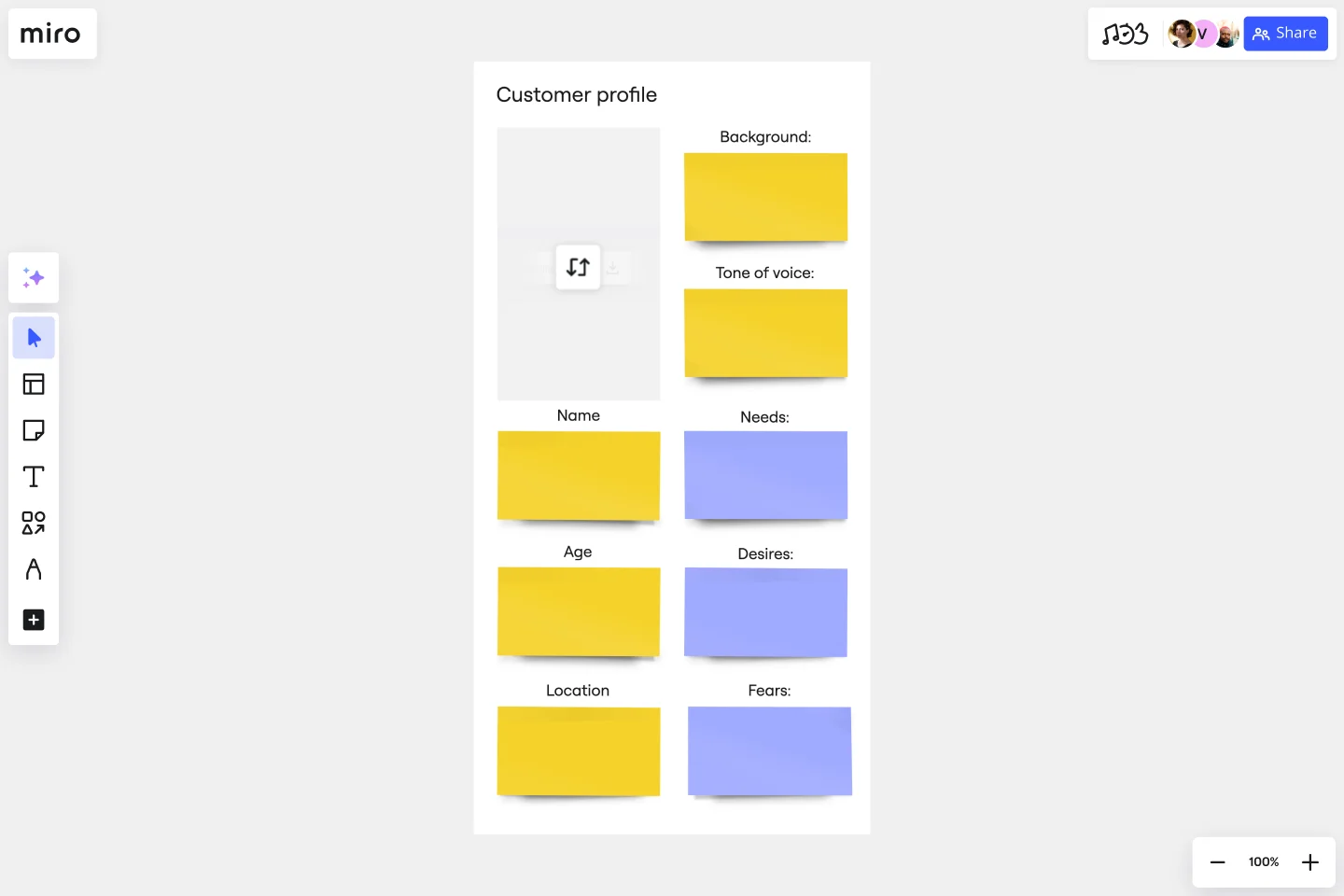Proto Persona Template
Tap into your target audience and foster empathy with the Proto Persona Template. Ensuring resonant solutions for design and strategy teams is now much easier.
About the Proto Persona Template
In today's digital landscape, the importance of user-centric design cannot be overstated. The Proto Persona Template offers a structured canvas to sketch out potential user segments, channeling the power of empathy and design thinking to ensure products and services resonate with their intended audiences.
What's a Proto Persona Template?
A proto-persona template is a visual tool crafted to represent and summarize the fundamental characteristics of a hypothetical user or customer. This lightweight, intuitive template outlines a user's presumed needs, behaviors, pain points, goals, and other attributes. It stands distinct from a full-fledged persona template, typically based on comprehensive user research and data. In contrast, a proto persona is based on educated assumptions and serves as a preliminary sketch, setting the stage for deeper user insights in later project phases.
Why should you use a Proto Persona Template?
Understanding and anticipating user needs is important in a world driven by user experience. The Proto Persona Template bridges the gap between initial design concepts and user-centric solutions, offering many advantages for teams and businesses. Here's why it's essential:
Empathy development: By sketching out the details of potential user segments, teams can cultivate empathy, allowing for designs and strategies that truly resonate with the user.
Enhanced collaboration: As a visual representation, the template fosters discussions, enabling teams to understand and ideate solutions around user needs and challenges collaboratively.
Iterative design: The dynamic nature of the template encourages teams to regularly revisit and refine their user understanding, aligning it with real-world feedback and insights.
How to use a Proto Persona Template in Miro
Embracing the Proto Persona Template is a journey of user-centric visualization and collaboration. Here's a step-by-step guide to harness its full potential:
Customize: Click on the different sections to edit and tailor them according to your project's specifics. Adjust colors, sections, and elements to make the template uniquely yours.
Expand: Given the dynamic workspace, you can extend the Proto Persona Template or introduce additional artifacts to the board, seamlessly integrating it within broader project contexts.
Duplicate and collaborate: If your project requires multiple proto personas, duplicate the template on your board. This feature promotes team-wide collaboration, allowing insights and feedback to be shared and integrated in real time.
Discover more target audience examples and understand your customers better.
Can I customize the Proto Persona Template?
The template is designed to be flexible. You can change sections, colors, and elements to align with your project's branding or preferred design.
Is the template suitable for multiple industries?
Yes, the Proto Persona Template is industry-agnostic. It's a foundational tool in user-centered design that can be employed across various sectors.
How many personas can I create using the template?
The template provides a structure for one persona, but our platform allows for duplication and expansion. Create as many personas as you need by duplicating the template on your board.
Do I need design experience to use the template?
Not at all! The Proto Persona Template is user-friendly and designed for both beginners and experts. Its intuitive layout ensures you can focus on the insights rather than the design intricacies.
Get started with this template right now.
Storyboard for Customer Journey Template
Works best for:
Storyboard
The Storyboard for Customer Journey template lets you map every touchpoint in the customer’s experience, from awareness to post-purchase. Capture customer actions, emotions, and pain points to better understand their journey. Ideal for marketers and CX teams, it reveals opportunities for improving customer satisfaction, driving engagement, and fostering loyalty through strategic insights and data-driven decisions
Fiction Storyboard
Works best for:
Storyboard, Planning, Design
Unleash your creativity with the Fiction Storyboard template. Perfect for writers and storytellers, this template helps you map out your fictional narratives, including plot points, character arcs, and scene transitions. It provides a structured framework to visualize your story's progression and ensure consistency. Use it to organize your ideas, explore different storylines, and create a compelling narrative that captivates your audience from start to finish.
Mood Board Template
Works best for:
Design, Brainstorming, Ideation
When you’re kicking off a creative project, it’s sometimes important to communicate the mood you’re trying to evoke — but it’s so hard to do it with words. So create a mood board and use images, color palettes, textures, and typography. Mood boards are also perfect for gathering inspiration and sketching out and pitching ideas, and they’re not just for designers — your content writers, sales teams, and product teams can use them too, and this template makes it easy for all of you to get started.
Niching Down: Online Course Persona Empathy Map
Works best for:
Market Research, Research & Design
Niching Down Online Course Persona Empathy Map helps you tailor online courses to specific personas. By understanding their needs and motivations, you can design more effective and engaging course content. Perfect for course developers and educators.
Mind Map Template
Works best for:
Design
Based on Joseph Novak's innovation, Concept Mapping, this template helps to organize ideas and demonstrate a comprehensive understanding of a subject. It visually arranges all the details about a topic, which fosters shared understanding. This technique is particularly useful when explaining different facets or related topics.
Pass the Paper
Collaborative brainstorming is an excellent method to facilitate a group of individuals in generating a diverse range of innovative concepts related to a specific problem. By encouraging participants to build upon each other's ideas, the process allows for rapid evolution and unexpected transformations. This collaborative approach, known as Round Robin, emphasizes collective authorship, with each person contributing their unique perspective. The ultimate outcome is a collection of ideas that surpasses the imagination of any individual.
